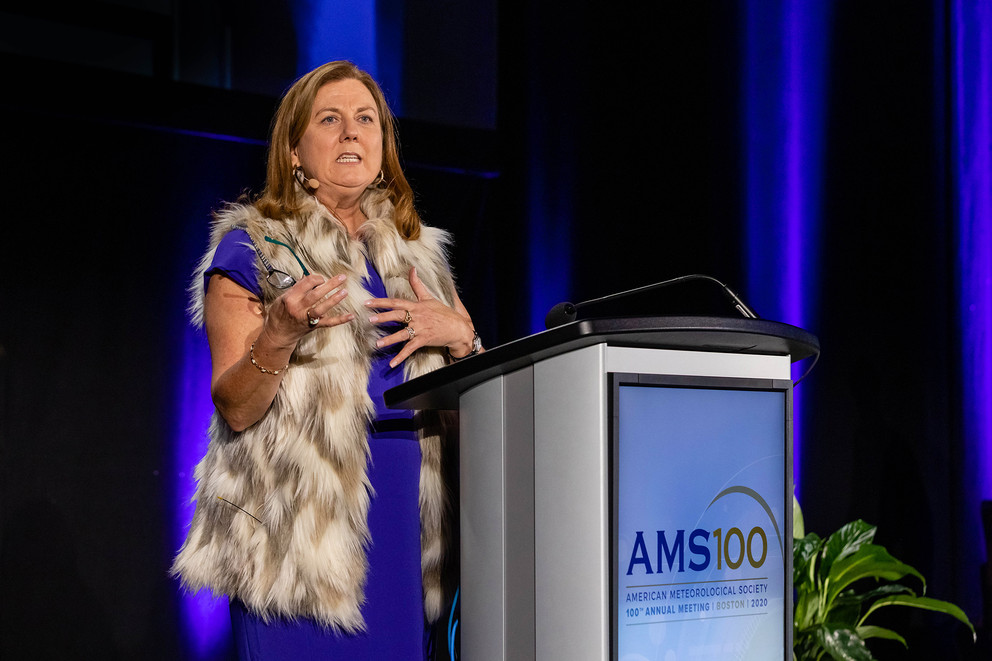
As president, Jenni Evans oversaw the 100th year of American Meteorological Society, a society dedicated to advancing the atmospheric and related sciences, technologies, applications and services for the benefit of society. IMAGE: AMERICAN METEOROLOGICAL SOCIETY
Penn State severe weather expert reflects on advances in the field
Posted on January 28, 2020UNIVERSITY PARK, Pa. — In her final days as president of the American Meteorological Society (AMS), Penn State severe weather expert Jenni Evans addressed more than 5,500 of the society’s members, reflecting on 100 years of advances in the field.
And what a time it’s been. The AMS is dedicated to advancing the atmospheric and related sciences, technologies, applications and services for the benefit of society. From its beginnings as a society focused on the new field of weather forecasting, the AMS has seen its role ever expanding and encompassing new realms and new technologies. Those areas include exploiting the increasing diversity of data types and applying advanced computation to improving the skill of weather forecasts, and gaining insight into climate change. More recently, the scope of the AMS has expanded to research and applications of advanced communications, sociology and psychology, economics and more.
Evans was drawn to taking on the leadership role at AMS. Her expertise in hurricanes — advanced with the help of supercomputing — led to her appointment as director of Penn State’s Institute for Computational and Data Sciences. And her role as an educator with the Department of Meteorology and Atmospheric Science made her think about the role AMS plays in the global field of meteorology, which her students will be a part of.
“I’m working with our next generation of leaders and thinking about where they can have the most impact as experts, and I’ve also been talking with many of the students about their roles in that future,” Evans said. “The AMS presidency was an opportunity to see how much better things could become as we embrace new opportunities and new directions. It was exciting to learn about how other people saw the field progressing.”
AMS’ 100th Annual Meeting began on Jan. 12 in Boston and featured speakers including Gina McCarthy, former EPA administrator and director of the Center for Climate Health and the Global Environment at the Harvard T.H. Chan School of Public Health.
Keith Seitter, executive director of AMS, praised Evans’ leadership ahead of the meeting.
“Serving as AMS president during the society’s centennial year, Jenni was able to participate in many special activities focused on the 100th anniversary of the premier organization dedicated to serving the atmospheric and related sciences leading up to the 100th AMS Annual Meeting,” Seitter said. “She helped organize this very special event and oversaw the centennial meeting to complete her year as president.”
Building on success
Named in 2010, Evans is one of about two dozen AMS Fellows representing Penn State. Fewer than two-tenths of 1% of the society’s members are named fellows. The rare distinction recognizes members who have made outstanding contributions to the field.
She said early faculty members of the Department of Meteorology and Atmospheric Science — the likes of Charles Hosler and Alfred Blackadar — positioned the department for success. But the department’s vision to remain on the cutting edge as the field expanded allowed Penn State to build on that success.
“We think about how the field is evolving and how we should be evolving,” Evans said. “We are constantly asking ourselves how we can contribute to the research and how we can prepare students who are ready to lead us into the future. That’s an ongoing process in the department and the College of Earth and Mineral Sciences.”
Forecasting the future
Advances in the field, and the use of new technologies, such as computers and satellites, have increased the impact meteorologists have on society every day. Today, people rely on experts to know when to evacuate and prepare ahead of natural disasters, to assess energy needs and fluctuations in industry demands, plan safe transport, and to understand risks such as climate change, Evans said.
Evans predicts that this impact will keep increasing as the field continues to adopt and find creative uses of emerging technologies.
“There are always opportunities available in new technologies,” Evans said. “And there are always opportunities in thinking about new ways of approaching the science.”
— By Patricia Craig
